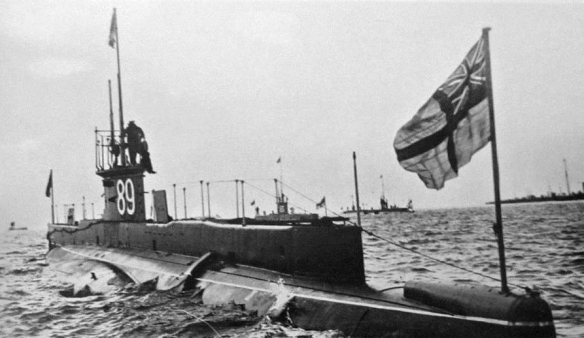HMS E9
The British fleet could not operate safely in the Baltic. The narrow, shallow seas were mined, and there were no nearby bases. Moreover, the German fleet could escape into the North Sea via the Kiel Canal. However, this area was ideal for submarine operations. An opportunity existed to send submarines into the Baltic area to interfere with German High Seas Fleet exercises and to interdict the iron ore trade with Sweden.
Consequently, in October 1914, the Admiralty sent three submarines to the Baltic: El under the command of LtCdr Noel Laurence, E9 under the command of LtCdr Max Horton and Ell under the command of LtCdr Martin Nasmith. The passage into the Baltic via the Skagerrak and Kattegat Straits and the narrow, shallow sound between Denmark and Sweden, was hazardous in the extreme. Both Horton and Laurence were able to dodge the enemy patrol vessels and make it into the Baltic. Nasmith, in Ell, was not so fortunate. Having left later than the first two submarines, he found the sound well patrolled and too dangerous to attempt an entry. After avoiding being rammed and bombed, Nasmith reluctantly gave up the attempt to break through. Before he could make another attempt, he was ordered to the Dardanelles.
These three commanders were the best in the British Submarine Service, and all of them were to become household names during the war. Horton, an irreverent chain-smoking gambler with a steely manner, had already made his mark as a commander by sinking the German cruiser Hela in the opening weeks of the war. He would later go on to command the Western Approaches in World War II and play a critical part in the defeat of the U-boats.
The two remaining submarines to make it into the Baltic encountered much shipping and local naval forces. Laurence was unlucky to miss the cruiser Victoria Luise, which saw the torpedoes racing toward her just in time. This announced to the Germans that British submarines were in the Baltic. It was decided to keep them there and base them at the Russian naval base at Lapvik, where they underwent repairs.
Remarkably, in January 1915, Horton set to sea, supported by an icebreaker. The conditions were so cold that it wasn’t certain that E9 would function. Horton discovered that the submarine worked fine when submerged, although her upper works froze when surfaced, needing the attention of a stoker with a chisel to keep ice from fouling the conning tower hatch. Horton made for the sound and unluckily missed a German destroyer when the torpedo veered off course and struck the seabed under its target, causing consternation in the German command, however, and curtailing operations in the area.
As the weather improved, Horton and Laurence became thorns in the side of the Germans. Operating both in harness and independently, they set about dismantling the iron ore trade and sank a number of transports, ore ships and a minelayer. In May Horton took on an escorted convoy and sank a transport under the nose of a German cruiser, forcing the convoy to double back to base. In June Horton attacked another escorted convoy and sank a transport and heavily damaged a destroyer, with only torpedo failure preventing him from adding a cruiser to his list of successes. In July Horton was again in action. This time he seriously damaged the cruiser Prinz Adalbert. This was a remarkable feat, due, in part, to the still, glassy sea, making any use of the periscope most dangerous. The Germans now began to refer to the Baltic as ‘Horton’s Sea’. Moreover, the Russian tsar decorated Horton with the Order of St George.
